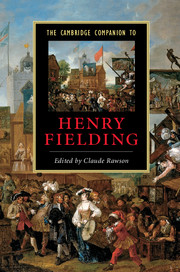Book contents
- Frontmatter
- Introduction
- 1 Henry Fielding’s life
- 2 Fielding’s theatrical career
- 3 Shamela
- 4 Joseph Andrews
- 5 Jonathan Wild
- 6 Tom Jones
- 7 Amelia
- 8 Fielding’s periodical journalism
- 9 Fielding and female authority
- 10 Fielding on society, crime, and the law
- 11 Fielding’s style
- 12 Fielding’s afterlife
- Guide to further reading
- Index
- Series List
12 - Fielding’s afterlife
Published online by Cambridge University Press: 28 July 2007
- Frontmatter
- Introduction
- 1 Henry Fielding’s life
- 2 Fielding’s theatrical career
- 3 Shamela
- 4 Joseph Andrews
- 5 Jonathan Wild
- 6 Tom Jones
- 7 Amelia
- 8 Fielding’s periodical journalism
- 9 Fielding and female authority
- 10 Fielding on society, crime, and the law
- 11 Fielding’s style
- 12 Fielding’s afterlife
- Guide to further reading
- Index
- Series List
Summary
One might envision Fielding’s afterlife as 'A Journey from This World to the Next' that travels through the Elysian field of novelists, where Fielding is greeted by his successors. The writers who welcome him are diverse: Smollett, Haywood, and Sterne; Burney and Austen; Scott and Byron; Dickens and Thackeray; Trollope and Meredith. European followers include Stendhal among the French, Pushkin and Gogol among the Russians. International modernists greet him as a precursor: Brecht, Mann, and Musil; Proust, Gide, and Joyce. These are joined by the comic novelists Evelyn Waugh, Kingsley Amis, Muriel Spark, Fay Weldon, David Lodge, Malcolm Bradbury, P. G. Wodehouse, and Tom Sharpe, as well as by the late modernist and post-modernist writers Gombrowicz, Kundera, Rushdie, Fowles, Coover, and Barth. They recognize in Fielding five images that identify his spirit as a novelist and that they have inherited: Fielding the self-conscious narrator, Fielding the ironist, Fielding the comic novelist, Fielding the creator of deep narrative patterns, and Fielding the immoralist.
Fielding the narrator
Henry Fielding and Samuel Richardson are traditionally regarded as progenitors of the English novel, and one of the implications of this dual ancestry is the delineation of two quite different kinds of novel. The Richardsonian novel purports to be lifelike, told by the participants or from the participants’ point of view, with little or no narrative intrusion to deflect from a direct relationship between readers and characters. In Fielding’s kind of novel the readers’ primary relationship is to the narrator, through whose eyes they see the characters and the action. The result, for naı¨ve readers, may be a certain restiveness with the narrator’s judgement, but the main effect is to throw the emphasis on plot rather than on the inner life of the characters.
- Type
- Chapter
- Information
- The Cambridge Companion to Henry Fielding , pp. 175 - 189Publisher: Cambridge University PressPrint publication year: 2007



